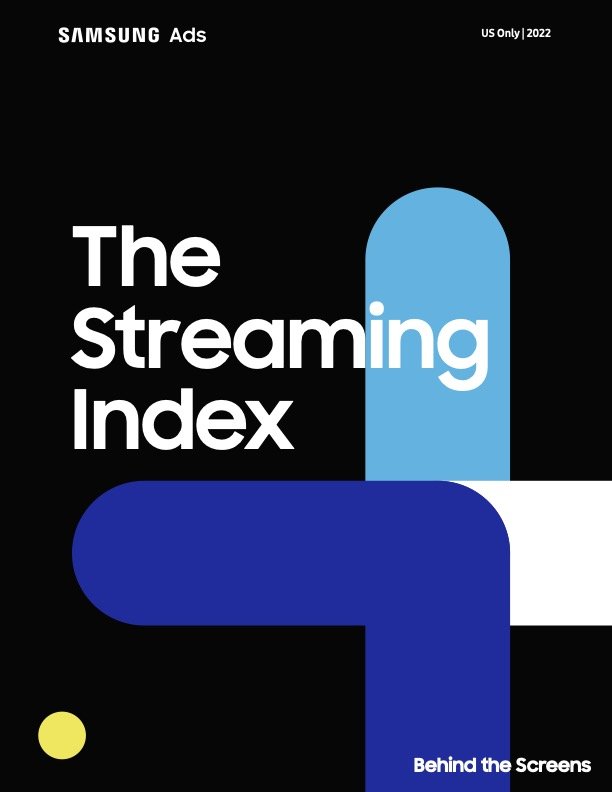Samsung Ads’ New Streaming Index Explores The Latest Streaming Behaviors, Trends and Motivations
While the streaming ecosystem is booming, most observations around consumer behavior in the space have been anecdotal. Which is why Samsung Ads’ new Streaming Index has been generating so much buzz: the report [download your copy here] relies on data from Samsung’s U.S. Smart TV footprint – the largest data set of its kind, based on tens of millions of TVs and over ten billion streaming viewing decisions.
This data is designed to help the many companies that have invested heavily in streaming apps make better, smarter, data-informed decisions, which in turn helps make the entire streaming ecosystem stronger and more successful.
To get a deeper dive into the report, we sat down with Justin Evans, Global Head of Analytics & Insights, Samsung Ads.
ALAN WOLK (AW): What were some of the key metrics you looked at in this report?
JUSTIN EVANS (JE): We really wanted to focus on the metrics that are most salient for the TV app marketer, namely, how is the audience growing in general? How are apps acquiring new users? What kind of retention is everyone seeing and what kind of churn is everyone seeing? Our goal is to make TV app marketers as effective as they can be at acquiring and retaining customers.
AW: Did you look at different categories of apps?
JE: We broke the sample up in several ways. The first was just subscription video on demand (SVOD) versus ad-supported video on demand (AVOD), as those have different business models. Then we divided them by tier. So we looked at the top 20%, the middle 20% and the remaining 60% of apps in our Samsung footprint.
Our hypothesis was that a larger app, one that already has a sizable installed audience, will have very different advertising and acquisition challenges than a smaller niche app that’s trying to find an audience for the first time. The former is also going to want to put effort into retaining customers, while the latter is going to want to primarily focus on acquiring them.
AW: What was the most surprising finding from the report?
JE: One of the most interesting things that came out of this analysis is a number which I thought really underlined the difference between streaming television and linear television: 3.8. That is the average number of apps Samsung TV viewers watched in Q4 2021.
Now compare that 3.8 to the dozens of channels people watch on linear in the course of an entire quarter—it’s a huge difference.
For TV app marketers, it means they’re facing big challenges when it comes to building awareness, but if they succeed, there’s a big payoff for being one of those 3.8 apps.
Streaming represents a real structural change in terms of how we look at TV audiences—your marketing has to bring viewers to the app, you can't assume they’re going to accidentally stumble on it as they’re flipping channels.
AW: If I was a brand manager at a company that is thinking of increasing my CTV budget, what are some findings I should be aware of?
JE: The most important finding for brands is that while SVOD apps are maturing, there's a lot of activity in the AVOD sector. There's a lot of trial and sampling and volatility in the AVOD sector, which is why we believe that brands really need to spread their bets across multiple AVOD providers in order to reach that critical streaming audience.
It’s also important to underline just how critical that streaming audience has become: in the Samsung ecosystem, about 75% of our users are mostly streamers. We did some work with Nielsen that showed that even outside of the Samsung footprint, about 50% of US homes are mostly streamers. So streamers are an increasingly important audience for brands to reach.
That is why we feel that brands need to spread their bets across multiple AVOD players to make sure they maximize their ability to reach those streaming audiences in such a volatile market.
AW: Based on the report, what advice would you give to Tier 2 or Tier 3 app owners?
JE: For Tier 2 apps, our advice would be that their promotions should focus on the ways their content differs from the content on Tier 1 apps. If you look at the Tier 1 apps, they’re almost like broadcast networks—they have something for everyone and so their content is very broad-based in order to appeal to as large an audience as possible.
The Tier 2 apps are sort of like the top level cable networks, where there is a specific value proposition, but it is still a little bit broad. What they need to do is to make people aware that they have the sort of content that can meet this specific need.
For Tier 3 apps, their value proposition for viewers is even more refined. They have niche content designed for a very specific audience. For those apps we recommend a more targeted data-based customer acquisition strategy.
As the rush to streaming is leveling off, it’s important for app owners to use their marketing dollars wisely. That's true at every Tier. The TV app marketers need to use television viewing data to really understand who their key audiences are for the use case they care about. Who are their churned users they need to win back? Who are their light users they can turn into a loyal repeat audience? Who is their niche viewer they need to hone in on? Having the data and doing the analysis is the critical first step to creating a deeper relationship with the audience.


